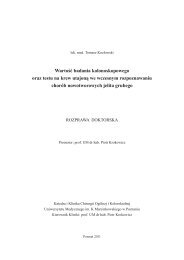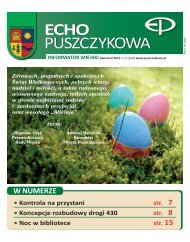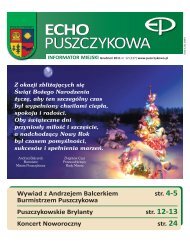MILITARY PHARMACY AND MEDICINE
MILITARY PHARMACY AND MEDICINE
MILITARY PHARMACY AND MEDICINE
You also want an ePaper? Increase the reach of your titles
YUMPU automatically turns print PDFs into web optimized ePapers that Google loves.
© Military Pharmacy and Medicine • 2012 • 4 • 12 – 16which contain antioxidants and microelementsseparately from PUFA-ω3, and which could betaken by the patient in line with the overall pictureof his ailments and treatment.It should be mentioned that many national andworldwide medical organizations (including theWHO) recommend daily intake of EPA and DHAin total amounts of 400–600 mg/day, while certainguidelines mention the dose of 1 g/day, andthe European Food Safety Authority (EFSA) holdsthe position that there is no scientifically supportedrecommended daily dose of PUFA-ω3 forhumans. However, EFSA recommends the DHAdose of 100 mg/day in infants, on the premise thatDHA contributes to the development and functionalmaturation of vision system; EFSA also recommendsa daily dose of ca. 250 mg (EPA + DHA)to children and adolescents aged 2-18 years [4] .On the other hand, a statement published in2010 by the French Safe Food Agency (AFSSA,currently MSNA — National Agency for Drugsand Health Products) recommends a daily doseof ca. 500 mg of EPA and DHA combined as apreventive measure in AMD patients. As seenfrom the presented data, the recommended dailydoses of PUFA-ω3 are diverse, cover a wide rangeof 100–1000 mg and depend on the patient’s ageand health status.What’s interesting, in case of cardiovascular conditions[5] , the recommended dosage of omega-3 fatty[4] By request of the European Commission, the EFSA Panel on Dietetic Products, Nutrition andAllergies (NDA) performed an analysis and issued a scientific opinion regarding acceptablemaximum daily intake of long-chain PUFA-ω3, i.e. EPA, DHA and DPA in humans. A studyentitled “Scientific opinion on the tolerable upper intake level of eicosapentaenoic acid(EPA), docosahexaenoic acid DHA) and docosapentaenoic acid (DPA)” was published in therecent issue of EFSA Journal [2012; 10(7): 2815]. In final conclusions, one reads: “The Panelconcludes that the available data are not sufficient to establish a tolerable upper intake levelfor n-3 LCPUFA (DHA, EPA, and DPA, individually or combined) for any population group. ThePanel considers that supplemental intakes of EPA and DHA combined at doses up to 5 g/day,and supplemental intakes of EPA alone up to 1.8 g/day, do not raise safety concerns for theadult population. The Panel also considers supplemental intakes of DHA alone up to 1 g/daydo not raise safety concerns for the general population. No data are available for DPA whenconsumed alone. The Panel notes that in the majority of the human studies considered, fishoils, which also contained DPA in generally unknown (but relatively low) amounts, were thesource of EPA and DHA.”[5] According to the European and American Heart Associations (EHA, AHA), all patientswith a history of myocardial infarction and patients with stable coronary disease shouldtake PUFA-ω3 at the dose of 1 g per day. According to AHA, supplementation using omega-3acids should not be associated with rigorous elimination of omega-6 acids (e.g. linoleic acid,C18:2-ω6, which accounts for 85-90% of dietary omega-6 acids) which cannot be synthesizedby human body and which, according to numerous opinion-forming sources, including theWHO, should account for 3-10% of daily energy demand. An interesting preparation thatmeets the AHA recommendations (although its omega-3 acid content is relatively small)is the “EYE Q capsules” preparation by a Swiss company Vifor SA distributed in Poland byQpharma; the product contains EPA and DHA (marine fish oil) and primrose oil (omega-6).Review articleacids (EPA + DHA + DPA) may be two-, three-,or even four times higher than the usually recommendedmaximum doses. When taken to reducethe triglyceride levels in hypertriglyceridemia, therecommended dose of PUFA-ω3 (with or withoutstatin or fibrate) may be up to 3-4 g per day.Regardless whether macular pigments andPUFA-ω3 are supplied together or as separatepreparations, below are the daily dose ranges (tobe contained in one capsule taken once daily orin two capsules taken twice a day) of the majoringredients of “ophthalmic” dietary supplementswhich, according to the author of this article,should be beneficial for AMD patients:••Lutein — 10–12 mg••Zeaxanthin — 1–2 mg••Vitamin E — 30–60 mg••Vitamin C — 60–250 mg••Zinc — 10–20 mg••PUFA-ω3 — 500–800 mg (overall, withDHA ≥ EPA)Optionally: meso-zeaxanthin (up to 10 mg),copper, selenium, manganese.The doses or dose ranges listed above are relativeand refer to both the compositions of productsavailable at Polish market and the experimentaland clinical data published on the topic.Products containing PUFA-ω3 should necessarilycontain vitamin E. The author’s opinion isthat there is no need to expand the compositionof an ophthalmic preparation by ingredients,e.g. vitamins, other than these listed above. Theaddition of meso-zeaxanthin, a macular pigmentcharacterized by potency equal to that ofzeaxanthin, may be beneficial for patients. Acomment should also be made with regard tothe content of lycopene, which is not discussedin this article. Although lycopene is not a macularpigment, it is worth to remember its role,as it is involved in repair of the three oxycarotenoids(lutein, zeaxanthin, meso-zeaxanthin)after they react with free radicals. Lycopene is acarotene featuring 11 conjugated double bonds,abundantly present in tomatoes. [6]With regard to the PUFA-ω3 content and DHAto EPA ratio in supplement preparations, the[6] For more information on lycopene in patients with AMD see Nowak, Wiktorowska-Owczarek, “AMD, Stargardt’s disease, and carotenoids as components of ophthalmicantioxidant preparations used in AMD” (Mag Lek Okul. 2012; 6(4): 185-98).12 http://military.isl-journals.com
















